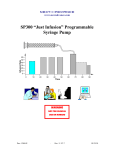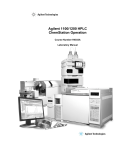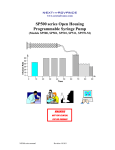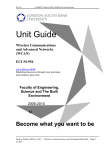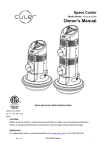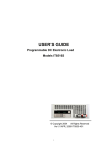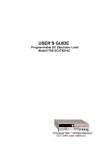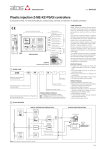Download Operator`s Manual
Transcript
Operator’s Manual Pressure Injection Cell Model PC8500 Congratulations! Congratulations on your purchase of a Next Advance Pressure Injection Cell. Please read this operator’s manual which explains proper operation of the instrument. This manual can also be viewed on the web at http://www.nextadvance.com/publi c/file/Press_Inject_Cell_PC8500_manu al.pdf Enjoy using your Pressure Injection Cell. We’re sure that it will work well for you and wish you good luck with your work. Contents Parts of the Pressure Injection Cell...... 2 Setting Up Your Pressure Injection Cell....................................................... 2 Using Your Pressure Injection Cell...... 2 Maintenance......................................... 4 Disconnecting and Reconnecting the Unit…………………………….……. 5 Troubleshooting .................................. 5 Support................................................ 5 Specifications....................................... 5 Warranty ............................................. 6 Safety Warning: Always turn off (or close the valves) at the pressure source and release any pressure from inside the pressure injection cell before opening the cell (removing the top) or connecting or disconnecting tubing to the cell. Never open the valves or try to pressurize the pressure injection cell without all connections properly tightened and the top securely bolted to the base of the cell. Do not use with more than 8500 psi. Wear protective eyewear. Users must be trained in working with high pressure systems and follow proper safety procedures and regulations. Operator’s Manual for the Pressure Injection Cell PARTS OF THE PC8500 PRESSURE INJECTION CELL SETTING UP YOUR PRESSURE INJECTION CELL USING YOUR PRESSURE INJECTION CELL Setting up the Pressure Injection Cell consists of attaching it to 1/8 inch (outside diameter) thick walled stainless steel tubing (not supplied with the PC8500 Pressure Injection Cell). First, slide the tubing through the inlet nut until it hits a stop. Finger-tighten the nut and then tighten it with a wrench for 1-1/4 turns. Connect the other end of the tubing to a pressurized gas tank. It is now set up. OVERVIEW Using the pressure injection cell requires removing the top, inserting your sample, replacing the top, and then inserting a capillary. Next, inject the sample using pressurized gas to force the sample through the capillary. After the injection, close the gas tank valve and open the 3-way valve to release the pressure. REMOVING THE TOP With the valves at the pressure source turned off and the 3-way valve BE SAFE. ALWAYS MAKE SURE THAT THERE IS NO PRESSURE IN THE CELL BEFORE LOOSENING THE BOLTS, AND THAT THE BOLTS ARE SECURELY FASTENED BEFORE APPLYING PRESSURE TO THE CELL. USERS MUST ALWAYS WEAR PROTECTIVE APPAREL, INCLUDING EYEWEAR AND MUST BE TRAINED IN WORKING WITH HIGH PRESSURE. 2 Operator’s Manual for the Pressure Injection Cell opened to release any pressure inside the cell, loosen the three bolts securing the top, 2 turns each. Rotate the top counterclockwise by 60 degrees so that the hexagonal sides are even. Then lift off the top. INSERTING THE SAMPLE Place the sample tube in the main hole of the base. The tube should not be capped. If the cap is hinged, you must cut off the hinge (with scissors). There is a recess in the top so the tube can protrude from the base, but a hinged cap will not fit in the recess. The sample tube protrudes from the base for easy insertion and removal. REPLACING THE TOP Confirm that the black O-ring is seated in its groove. Slip the top onto the base, rotate the top 60 degrees clockwise, and then tighten the three bolts using a hex wrench. Use a hex wrench to tighten the three bolts. INSERTING A CAPILLARY Loosen the nut covering the white ferrule using a wrench. Slide the capillary through the small hole in the ferrule, until it reaches the bottom of the sample tube. Tighten the nut, thereby squeezing the ferrule tightly around the capillary. To remove the capillary, loosen the nut and slide the capillary out. INJECTING A SAMPLE First point the knob on the 3-way valve towards the stainless steel tubing connected to the gas tank. Then, while looking away from the gas tank gages and with your hand covering them (in case they explode when the pressure is turned on) open the gas tank valve. Adjust the pressure regulator to the desired pressure. When the injection is finished, close the gas tank valve. Then turn the BE SAFE. ALWAYS MAKE SURE THAT THERE IS NO PRESSURE IN THE CELL BEFORE LOOSENING THE BOLTS, AND THAT THE BOLTS ARE SECURELY FASTENED BEFORE APPLYING PRESSURE TO THE CELL. USERS MUST ALWAYS WEAR PROTECTIVE APPAREL, INCLUDING EYEWEAR AND MUST BE TRAINED IN WORKING WITH HIGH PRESSURE. 3 Operator’s Manual for the Pressure Injection Cell knob on the 3-way valve so that it points toward the vent. This depressurizes the injection cell. Now you can loosen the nut over the ferrule and remove the capillary, loosen the three bolts, remove the top, and remove your sample tube. Photograph of a 1 ml tube with a hinged cap (left) and of a 1 ml tube with the hinge cut off and the bottom placed in an adapter composed of soft tubing (right). Use a wrench to tighten the nut, forcing the ferrule to squeeze tightly around the capillary. USE OF ADAPTER FOR 1 ML TUBES We supply one adapter with the pressure injection cell so that 1 ml tubes are as easy to work with as taller tubes. The central hole in the base of the pressure injection cell is sized so that 1.5 or 2 ml sample tubes will protrude above the surface, making placement and retrieval easy. A (surprisingly) simple adapter will enable 1 ml microcentrifuge tubes to protrude, too. The adapter is a piece of soft tubing (1/4 inch inside diameter, 3/8 inch outside diameter). As with any tube with a hinged cap, first cut off the hinge so that the top of the tube will fit in the recess in the top of the pressure injection cell. Next, slide the adapter onto the bottom of the 1 ml sample tube, as shown in the figure below. MAINTENANCE Periodically, the Teflon ferrule should be replaced. Simply remove the nut covering the ferrule, remove the BE SAFE. ALWAYS MAKE SURE THAT THERE IS NO PRESSURE IN THE CELL BEFORE LOOSENING THE BOLTS, AND THAT THE BOLTS ARE SECURELY FASTENED BEFORE APPLYING PRESSURE TO THE CELL. USERS MUST ALWAYS WEAR PROTECTIVE APPAREL, INCLUDING EYEWEAR AND MUST BE TRAINED IN WORKING WITH HIGH PRESSURE. 4 Operator’s Manual for the Pressure Injection Cell ferrule, place a new ferrule, tapered side down into the fitting, and replace the nut. Your pressure injection cell comes with 10 ferrules (plus one installed in the top). Additional ferrules can be purchased directly from Chromatography Research Supplies (part number 214204, 1/8” to 0.4mm PTFE ferrules), at www.chromres.com DISCONNECTING AND RECONNECTING THE UNIT Before you disconnect the pressure injection cell, mark lines on the nut and the valve, close the valves by the pressure source, and release any pressure inside the cell by opening the 3-way valve. When you reconnect the unit, you can use the same ferrule and tubing. Simply tighten the nut slightly more than last time. You should feel the wrench get very hard to turn once you go beyond the nut’s previous position. TROUBLESHOOTING In addition to the tips given below, a thorough list of troubleshooting tips is at http://www.nextadvance.com/api/index. cfm/cms.page/i/5063/pressureinjection-cell-troubleshooting. If gas leaks through the top-base interface of the pressure injection cell, the three bolts might not be fully tightened or the O-ring might be nicked or dirty or missing. If the O-ring is dirty, wash it off with a soap and water and return it to its groove. Contact us for a replacement O-ring. If gas leaks around the capillary, the ferrule should be replaced. If you do not see sample traveling through the capillary after a few minutes, check that the gas tank is supplying the desired pressure (typically on the order of several hundred psi) and that the 3-way valve knob is pointing toward the pressurized gas line. SUPPORT A thorough list of FAQs is at http://www.nextadvance.com/api/index. cfm/products.info/c/427/PressureInjection-Cell-Capillary-Loader#/FAQ. If you cannot find a good answer there, please contact customer service by email at [email protected] or by telephone. SPECIFICATIONS Max. Pressure: 8500 psi Size: 11 in long x 4 in wide x 3 ¼ in. high BE SAFE. ALWAYS MAKE SURE THAT THERE IS NO PRESSURE IN THE CELL BEFORE LOOSENING THE BOLTS, AND THAT THE BOLTS ARE SECURELY FASTENED BEFORE APPLYING PRESSURE TO THE CELL. USERS MUST ALWAYS WEAR PROTECTIVE APPAREL, INCLUDING EYEWEAR AND MUST BE TRAINED IN WORKING WITH HIGH PRESSURE. 5 Operator’s Manual for the Pressure Injection Cell WARRANTY Next Advance warrants its Products against defects in materials and workmanship for time periods which vary according to the Product. Within these time periods, Next Advance will replace or repair, without charge to the original purchaser, any part which is defective. Pressure Injection Cells Two years The warranty is void if the Product is defective due to product accident, product modification, exposure to radiation other than for sterilization, connection to an improper electrical supply, lack of proper maintenance, contamination, improper installation or misuse. If the product is used in a manner not specified by the manufacturer, the protection provided by the equipment may be impaired. The warranty shall also not apply to defects arising from fire, flood, lightning or other conditions unrelated to correct operation of the Product. Next Advance’s liability is limited, at the company’s election, to (1) refund of the original purchaser’s purchase price for the Product (2) repair of the Product, or (3) replacement of the Product or defective parts. Evidence of purchase by the original purchaser is required. Next Advance may also request documentation of proper maintenance, if applicable. Next Advance makes no other warranty,express or implied, with respect to its Products. NEXT ADVANCE MAKES NO WARRANTY RESPECTING THE MERCHANTABILITY OF THE PRODUCTS OR THEIR SUITABILITY OR FITNESS FOR ANY PARTICULAR PURPOSE OR USE. Next Advance shall not be liable for, indirect, special, incidental or consequential damages of any nature. Any recovery for any claim shall be limited to the original purchase price for the product. WARNINGS AND CAUTIONS Read the user’s manual before operating. For indoor use only. Do not use with more than 8500 psi. Wear protective eyewear. Users must be trained in working with high pressure systems and follow proper safety procedures and regulations. OPERATOR’S RESPONSIBILITY Provide proof of purchase and provide normal care and maintenance. BE SAFE. ALWAYS MAKE SURE THAT THERE IS NO PRESSURE IN THE CELL BEFORE LOOSENING THE BOLTS, AND THAT THE BOLTS ARE SECURELY FASTENED BEFORE APPLYING PRESSURE TO THE CELL. USERS MUST ALWAYS WEAR PROTECTIVE APPAREL, INCLUDING EYEWEAR AND MUST BE TRAINED IN WORKING WITH HIGH PRESSURE. 6 Operator’s Manual for the Pressure Injection Cell CONTACT INFO Next Advance, Inc. Averill Park, NY, USA Telephone 518-674-3510 www.nextadvance.com Email: [email protected] [email protected] [email protected] BE SAFE. ALWAYS MAKE SURE THAT THERE IS NO PRESSURE IN THE CELL BEFORE LOOSENING THE BOLTS, AND THAT THE BOLTS ARE SECURELY FASTENED BEFORE APPLYING PRESSURE TO THE CELL. USERS MUST ALWAYS WEAR PROTECTIVE APPAREL, INCLUDING EYEWEAR AND MUST BE TRAINED IN WORKING WITH HIGH PRESSURE. 7












